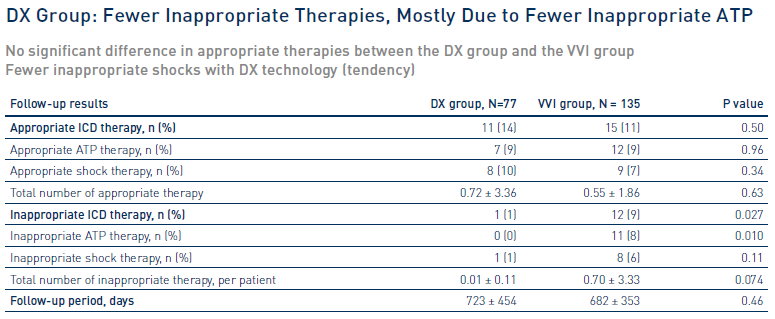Kurt et al. (2018)
Avoiding inappropriate therapy of single‐lead implantable cardioverter‐defibrillator by using atrial‐sensing electrodes
Kurt M et al., Journal of Cardiovascular Electrophysiology, September 2018. doi: 10.1111/jce.13736
Investigator-initiated trial, not funded by BIOTRONIK
Study Design
- Prospective, single-center, non-randomized study
Key Result 1

Key Result 2

Key Result 3

Clinical Relevance
-
Use of single-chamber ICDs can result in significant adverse events, such as inappropriate ICD therapies most commonly caused by AF and supraventricular tachyarrhythmias
-
It has been well known that the incidence of inappropriate ICD therapy is associated with poor patient outcomes
-
The efficacy of the DX-ICD system for preventing inappropriate ICD therapies may lead to improvements not only in the quality of life, but also possibly in the prognosis of the patients
| Study Objective |
|
|---|---|
| Primary Endpoint |
|
| Secondary Endpoint |
|
| Clinical Sites |
|
| Sample Size |
|
| Main Inclusion Criteria |
|
| Main Exclusion Criteria |
|
| Products |
|
| Follow-Up |
|
| Reference no. |
|
1 Priori SG, Blomström‐Lundqvist C, Mazzanti A, et al. Task Force for the Management of Patients with Ventricular Arrhythmias and the Prevention of Sudden Cardiac Death of the European Society of Cardiology (ESC). 2015 ESC Guidelines for the management of patients with ventricular arrhythmias and the prevention of sudden cardiac death: the Task Force for the Management of Patients with Ventricular Arrhythmias and the Prevention of Sudden Cardiac Death of the European Society of Cardiology (ESC) Endorsed by: Association for European Paediatric and Congenital Cardiology (AEPC). Europace. 2015;17:1601‐1687
